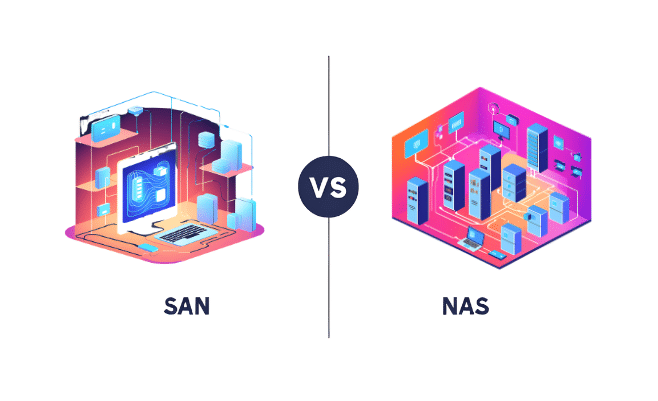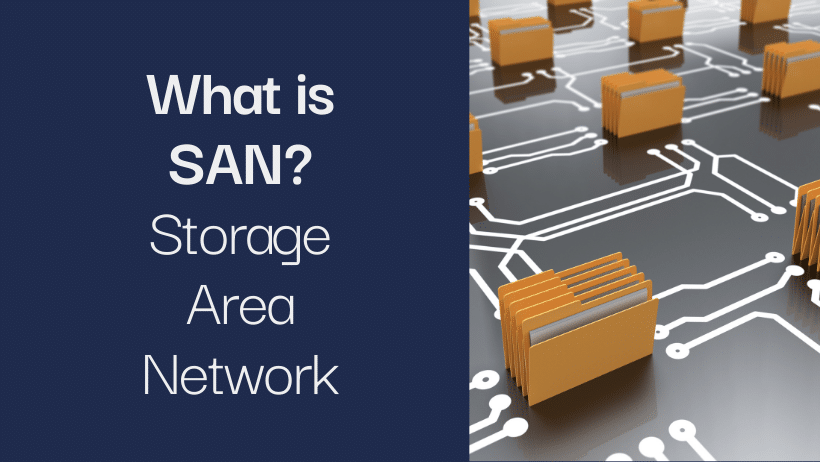SAN vs NAS: Choosing the Right Network Storage Solution for Your Business

In the world of data storage, two major concepts often come to the forefront: Storage Area Network (SAN) and Network Attached Storage (NAS). Both offer centralized storage solutions. While both solutions aim to optimize data accessibility and collaboration, they’re architected differently and cater to distinct performance, scalability, and management needs. In this article, we’ll explore SAN vs NAS in detail, diving into how each system works, their use cases, and how they integrate with modern solutions like MyWorkDrive.
Contents
- SAN vs NAS: Choosing the Right Network Storage Solution for Your Business
- What is a SAN (Storage Area Network)?
- What Is NAS (Network Attached Storage)?
- SAN vs NAS: Key Differences
- Choosing the Right Solution for Your Business
- NAS Use Cases
- High Performance SAN Use Cases
- NAS and SAN Convergence
- SAN, NAS, and MyWorkDrive: Bridging Gaps in Modern Work Environments
- Final Thoughts on SAN vs NAS
What is a SAN (Storage Area Network)?

A Storage Area Network (SAN) is a dedicated, high-speed network that provides access to consolidated block-level storage. SANs provide fast data access, which is essential for supporting a large number of users simultaneously. It appears to each host system as if the storage were a locally attached hard drive, thereby delivering exceptionally low latency and high throughput.
- Connectivity: Typically uses Fibre Channel (FC), Fibre Channel over Ethernet (FCoE), or iSCSI to connect storage devices and servers.
- Performance: Designed for rapid data transfers and real-time access, making it an excellent fit for enterprise applications that demand speed.
- Scalability: SAN architectures can be expanded by adding more storage devices without degrading network performance, which is crucial for large-scale data growth.
- Complexity: Generally requires specialized knowledge and dedicated administration, which can increase costs and complexity.
How SAN Works
A SAN solution is block storage-based, splitting data into logical volumes and distributing these blocks across physical or virtual disks. This architecture allows you to format and partition storage resources using protocols such as iSCSI or Fibre Channel Protocol (FCP).
SANs are composed of three distinct layers:
- Storage Layer
- Comprises the physical storage drives or virtualized storage pools.
- Data is stored in logical blocks, facilitating better redundancy and quick failover in case of hardware issues.
- Fabric Layer
- The communication backbone connecting servers to storage via switches and cables (FC, FCoE, or iSCSI).
- Offloads data traffic from the LAN, improving overall bandwidth and reducing bottlenecks.
- Host Layer
- Represents the servers and applications that see SAN storage as if it were a locally connected drive.
- Ensures rapid read/write speeds and seamless data sharing across different hosts.
vSANs (Virtual SANs)
A vSAN leverages virtual machines (VMs) running on one or multiple hosts, pooling their local or direct-attached storage into a shared resource. This virtualized environment simplifies management and offers:
- Cloud Scalability: Dynamically increase or decrease resources based on your workload.
- Enhanced Security: Containment and segmentation within virtual environments.
- Reduced Hardware Footprint: Minimize the need for additional physical storage arrays.
What Is NAS (Network Attached Storage)?

A Network Attached Storage (NAS) device is a file-level storage device connected over a common network—usually Ethernet—that provides shared access to files and directories, making it ideal for environments where multiple users require concurrent access to shared files.
- Connectivity: Operates through standard TCP/IP protocols (SMB, NFS, CIFS, or HTTP), making it simpler to deploy and manage than SAN.
- Affordability: Generally lower-cost entry points for small to medium-sized businesses or home offices.
- Ease of Use: Offers plug-and-play installations, intuitive management interfaces, and straightforward file-sharing capabilities.
How NAS Works
NAS solutions are file storage-based, meaning data is organized in a hierarchical structure of directories, subdirectories, and files, similar to volumes on a file server. When a user makes a request, the NAS device processes it at the application layer and returns the file over standard network protocols like SMB (Server Message Block) or NFS (Network File System).
A typical NAS system consists of:
- Network
- Connects one or multiple NAS devices to a LAN or Ethernet network, each with its own IP address.
- NAS Box
- A hardware appliance (also called a NAS head) that includes a network interface card (NIC), CPU, memory, and drive bays for housing multiple disk drives.
- Storage (Drives)
- Often configured in RAID arrays to distribute and replicate data across multiple disks for redundancy and performance boosts.
- Operating System
- A dedicated OS that manages data-sharing requests and enforces access controls.
- Software
- Preconfigured software to handle file-sharing protocols and user authentication.
SAN vs NAS: Key Differences
Both SAN and NAS facilitate network-based data access. However, deciding between SAN vs NAS often comes down to performance requirements, scalability demands, and budget constraints. Here are the major distinguishing factors:
- Network Type
- SAN: Relies on a high-speed Fibre Channel or iSCSI fabric.
- NAS: Connects via a standard Ethernet network (LAN).
- Data Access Layer
- SAN: Block-level storage.
- NAS: File-level storage.
- Setup and Management
- SAN: More complex to deploy and maintain, requiring specialized storage administrators.
- NAS: Easier to set up, often “out-of-the-box” solutions suitable for small businesses to large enterprises.
- Performance
- SAN: Lower latency and higher throughput—preferred for mission-critical workloads.
- NAS: Adequate performance for many business applications but may experience slower throughput under heavy concurrency.
- Scalability
- SAN: Highly scalable through adding more storage arrays and switches.
- NAS: Easy to scale at first by adding more NAS devices, though large-scale deployments can become complex and costly.
- Cost
- SAN: Higher total cost of ownership due to specialized hardware and administration.
- NAS: Budget-friendly options available, with simplicity translating to lower ongoing costs.
Choosing the Right Solution for Your Business

When it comes to choosing between NAS and SAN for your business, it’s essential to consider your specific needs and requirements. Here are some factors to consider:
- Scalability: If your business anticipates significant data growth and requires high-performance access, a SAN might be the better choice. SANs are designed to handle large-scale data storage and can be expanded without compromising performance. On the other hand, if your data storage needs are more modest and you prioritize ease of use, a NAS solution might be more suitable.
- Budget: SAN solutions tend to be more expensive than NAS solutions, especially for small to medium-sized businesses. However, the investment in SAN can be justified for larger enterprises that need the high performance and scalability it offers. NAS solutions, with their lower cost and simpler management, are often a better fit for smaller businesses or home offices.
- Data Type: The type of data you need to store can also influence your decision. NAS is ideal for storing large amounts of unstructured data, such as video files, images, and documents, due to its file-level storage capabilities. Conversely, SAN is better suited for structured data, such as databases and virtual machines, where block-level storage provides the necessary performance and reliability.
- User Access: Consider how many users need to access the data simultaneously. SANs are designed to support multiple users accessing data concurrently with minimal latency, making them ideal for environments with high user demand. NAS solutions can also support multiple users but may experience slower performance under heavy load.
By evaluating these factors, you can make an informed decision about whether NAS or SAN is the right choice for your business, ensuring you select a solution that meets your performance, scalability, and budgetary needs.
NAS Use Cases
- File Collaboration and Storage
- Ideal for mid-to-large enterprises looking to consolidate multiple file servers into a single centralized system for streamlined access.
- Archiving
- Storing large volumes of files in a searchable and accessible archive. NAS appliances often include snapshot and data backup features.
- Big Data
- Efficient for handling large, unstructured data sets and supporting analytics and ETL processes where file-level access is sufficient.
High Performance SAN Use Cases
- Video Editing
- Professional video editing requires high throughput and minimal latency. SANs connect directly to editing stations, bypassing additional network hops.
- E-Commerce
- High-performance data transactions ensure seamless shopping experiences, even under heavy traffic loads.
- Backup/Disaster Recovery
- SAN’s block-level architecture and dedicated network speed up backups and restores, allowing businesses to access data quickly, which is especially important for business continuity.
NAS and SAN Convergence
In recent years, there has been a trend towards convergence between NAS and SAN solutions. This convergence is driven by the need for more flexible and scalable storage solutions that can meet the demands of modern businesses.
SAN, NAS, and MyWorkDrive: Bridging Gaps in Modern Work Environments
Contemporary organizations often employ multiple storage technologies. Understanding SAN vs NAS and how they integrate into a broader IT strategy is critical for businesses looking to optimize data availability and collaboration.
MyWorkDrive offers a modern solution for securely accessing and sharing data stored on both SAN and NAS systems. With MyWorkDrive, teams can:
- Eliminate VPN Bottlenecks: Access files remotely via a web browser, mapped network drives, or mobile devices without traditional VPN complexities.
- Maintain Security and Compliance: Enforce stringent file-level permissions and data governance, ensuring sensitive information remains protected.
- Enhance Productivity: Whether you have lightning-fast block-level storage on a SAN or a user-friendly NAS environment, MyWorkDrive ensures seamless, real-time access for distributed workforces.
MyWorkDrive with SAN
While MyWorkDrive doesn’t manage SAN infrastructure directly, it provides a secure gateway for remote users to access SAN-hosted data. This keeps mission-critical files at optimal performance levels while offering global accessibility.
MyWorkDrive with NAS
MyWorkDrive seamlessly integrates with NAS devices, enabling employees to collaborate on files in real-time from any location. Rather than juggling multiple remote access solutions, teams benefit from a unified interface and robust security controls.
Final Thoughts on SAN vs NAS
Choosing between SAN vs NAS isn’t a one-size-fits-all decision; it hinges on factors like performance requirements, budget constraints, IT expertise, and organizational growth plans. SAN delivers high performance and low latency for demanding workloads, whereas NAS provides a cost-effective, user-friendly solution for file sharing and collaboration.
By leveraging a platform like MyWorkDrive, businesses can unify file access across these two storage paradigms—empowering remote teams, strengthening data security, and ultimately driving operational efficiency.
Ready to streamline your file-sharing strategy? Explore how MyWorkDrive can unlock secure, flexible access to all your SAN and NAS resources. Whether you’re handling sensitive e-commerce transactions, large media files, or routine office documents, MyWorkDrive bridges the gap between on-premises storage and the modern, distributed workforce.
